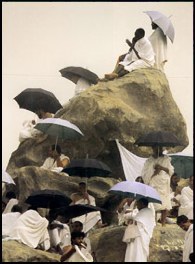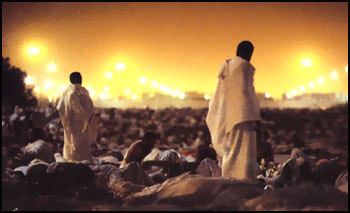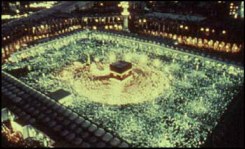ourIslamOnline.net | home
2nd Step
The JOURNEY
No matter when they arrived in Mecca, early in the morning on the eighth day of Hijjah, the pilgrims all take to the roads leading out of town toward Mina Valley. By the next morning, Mecca will be virtually empty. This exodus of some two million white robed people is the start of a five-day journey into the desert. It is a period in which the whole Hajj population gives up its usual comforts and returns to the basic metaphor of life as a journey on the earth. During this period, pilgrims trade their usual existence for life in a tent on the sand. This exchange of urban amenities for a more timeless desert life further dissolves class distinctions and binds the Hajj community more closely.
The MINA VALLEY
Dawn to Midnight, Day Two - For 50 weeks of every year, Mina is an empty desert valley about 10 miles long, with a smattering of buildings, long stretches of low dunes, and bare granite mountains rising on all sides.
During the Hajj season, however, every square inch of sand here is packed with several hundred thousand-canvas tents arranged in quadrangular sectors the size of small villages. Hour after hour, 2 million pilgrims pour toward them by every means at hand. Seen from the hills after dark, with lamplight shining in every tent, the valley resembles a long canal dotted with small ships. The traffic jams wind over the mountains into Mina until well after midnight.
The ARAFAT
 Day Three - The next morning the mass exodus pushes five more miles east to the Plain of Arafat, a barren stretch of sand marked by a single foothill, called Mount Mercy. Here the zenith of the Hajj occurs.
Day Three - The next morning the mass exodus pushes five more miles east to the Plain of Arafat, a barren stretch of sand marked by a single foothill, called Mount Mercy. Here the zenith of the Hajj occurs. The Hajj is designed to deliver you to Arafat with an open heart and an attentive conscience. From sun up through the rest of the day, the mobile population of the Hajj streams onto this wide plain, where thousands of tents have already been raised, in many cases arranged by nationality.
Arafat is a daylong vigil in which everyone present gathers together to stand in the presence of God. It is a high occasion but light on ceremony--the normal daily prayers are shortened, and a brief sermon punctuates the afternoon. The real point of this event, called the Day of Standing, is simply to be there, to be a participating witness. This is the heart of pilgrimage.
The RUSH
Day Three - At sundown, the pilgrim route loops back toward the Mina encampments. The enormous procession becomes a recessional. The entire population rises up and leaves the Plain of Arafat.
The MUZDALIFAH
 Evening Day Three, Day Four - On the way, this mobile pilgrim city halts at a patch of hills and pebbled plain called Muzdalifah. Here the pilgrims stop for the night, to rest, to eat, to gather stones for the following day, and to keep a nightlong vigil that is a mirror image of the day on Arafat. With the moon on the hills, the scents of cooking filling the night air, and the acme of the pilgrimage behind them, the pilgrims take a much-needed breath. By this time, the Hajj has been on its feet for many, many hours.
Evening Day Three, Day Four - On the way, this mobile pilgrim city halts at a patch of hills and pebbled plain called Muzdalifah. Here the pilgrims stop for the night, to rest, to eat, to gather stones for the following day, and to keep a nightlong vigil that is a mirror image of the day on Arafat. With the moon on the hills, the scents of cooking filling the night air, and the acme of the pilgrimage behind them, the pilgrims take a much-needed breath. By this time, the Hajj has been on its feet for many, many hours. At dawn, the crowds begin to move along again in the direction of Mina to take part in the final rights.
The STONING TEMPTATION
 Day Four - At dawn, pilgrims set out to accomplish one of the last of the Hajj rites: the ancient practice of stoning three pillars that symbolize temptation. Each pilgrim approaches the first pillar with one thing in mind: to aim well enough to hit the mark seven times.
Day Four - At dawn, pilgrims set out to accomplish one of the last of the Hajj rites: the ancient practice of stoning three pillars that symbolize temptation. Each pilgrim approaches the first pillar with one thing in mind: to aim well enough to hit the mark seven times. The symbolism of the act is quite important: The Hajj has left its pilgrims with a clean conscience. But what about tomorrow? How will they maintain this state of awareness when they leave? The stoning is a form of athletic practice, a symbolic act designed to drive home the message that human error, sin, is a matter of missing the target; that if your aim is true, the pillar of wrong can be brought down by a little kernel of right action. Like the other rites, this simple act is full of meaning.